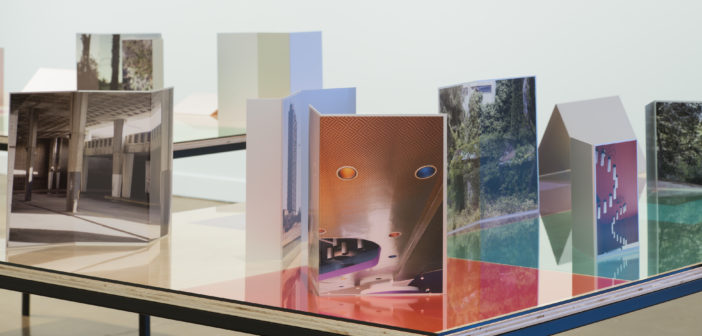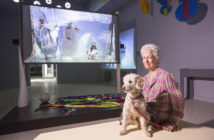Upon entering the Paris-based Charlotte Moth’s exhibition Seeing While Moving at the MIT List Visual Arts Center I felt an overwhelming sense of nostalgia. While the show has since closed to the public, its sentiment is timely. In a pop culture flooded with re-surging trends and reboots, Seeing While Moving lets the viewer slip into someone else's past, making the experience accessible and familiar without ever having to experience the event. Charlotte Moth has since been nominated for the 2017 Prix Marcel Duchamp prize, France's most important award for contemporary art, her work will be displayed at the Central Pompidou this coming October.
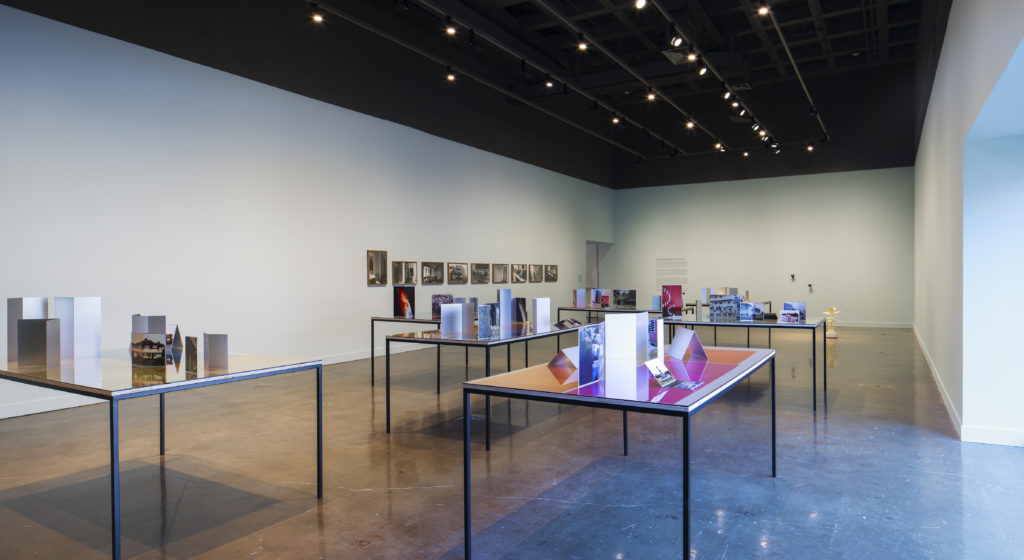
Exhibition installation view of Charlotte Moth: Seeing while Moving at MIT
List Visual Arts Center, Cambridge, MA (February 17–April 16, 2017)
Photo: Peter Harris Studio
The List Centers large white rectangle gallery's size almost dwarfs Moth’s intimate photographs and table sculptures. Most of the space is occupied by tables positioned so that the viewer can enter and exit their intimate clusters from multiple points. In the back, the quiet hum of a slide projector clicks through photographs like a ghost of vacations past. The projections are of interiors, appearing fuzzy and tender, adding to the quiet intimacy of its action. As a lover of the kitsch, homey, and things Midwestern, I looked at these objects as greeting cards on the ubiquitous “auntie" table. Other people’s vacations and trips proudly displayed on a table or mantlepiece. An air of “wish you were here,” hangs above the little soldier sculptures, each holding their own weight and sense of self-importance. Seeing while Moving, which was Moth’s first solo show in the US, unfolds in a quiet, subtle way, like a postcard lovingly placed on display, a fragmented memory given to someone to share in. Hence my nostalgia.
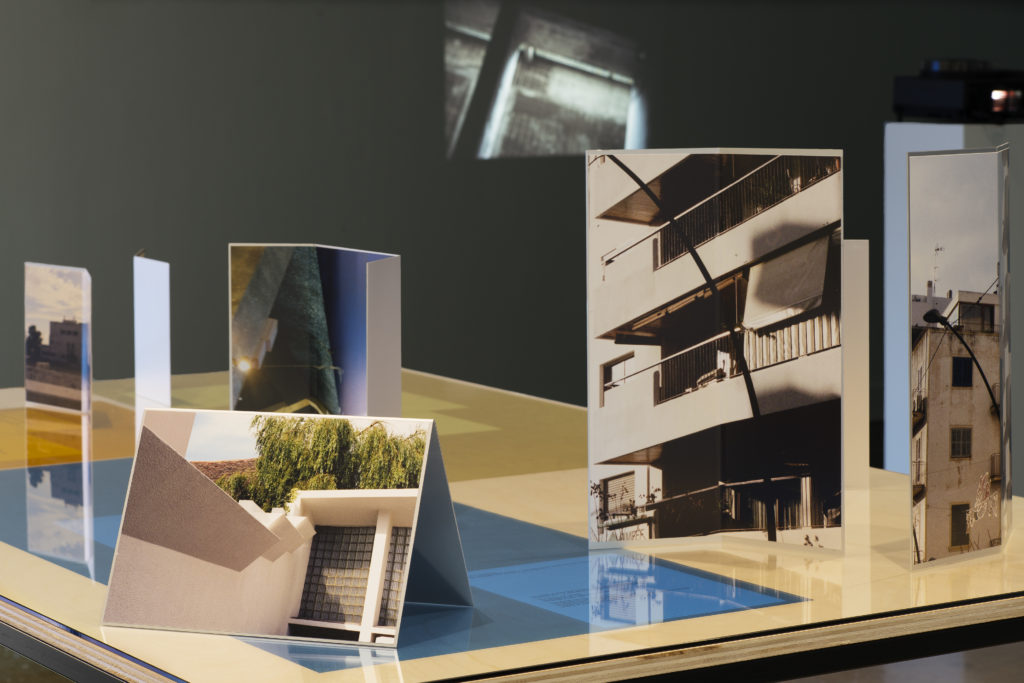
Exhibition installation view of Charlotte Moth: Seeing while Moving at MIT
List Visual Arts Center, Cambridge, MA (February 17–April 16, 2017)
Photo: Peter Harris Studio
Seeing While Moving’s centerpiece is an assemblage entitled Noting Thoughts (2011). The piece consists of photographs from Moth’s ongoing Travelogue, started in 1999. With subject matter mostly consists of objective landscapes, the compositions are general, allowing the eye to move in and out of the bushes obscuring an apartment building. The location of the images are never disclosed but come from Moth’s international travels. The images themselves range from moody, atmospheric and nonspecific, too focused and indulgent. For instance, one image focuses on a palm frond captured mid breeze, reflecting a moment of transition. They act as little vignettes and points of entry into someone else's world, asking us to imagine the photographer who found that particular apartment building important enough to capture. Each photograph is mounted on metal plates so that it is supported by its own weight, either bent at an angle or literally unfolding as an accordion book. Placed under the photos are fragments of texts and prose, taken from poetry or essays on photography, tucked under colored transparent sheets. One particularly sensitive passage sits under a fluorescent pink sheet of reads, “A metaphor for all places, any place” and to its right, an angled image that seems like the candy stripes of a carnival tent sandwiched between grey sand and an overcast day. The sculptural photos converse with their designated phrases, inviting the viewer to look further into a “reading” of the image. This passage sums up much of the feeling of Noting Thoughts; a presentation of places, held up by their own weight, becoming places and place holders themselves.
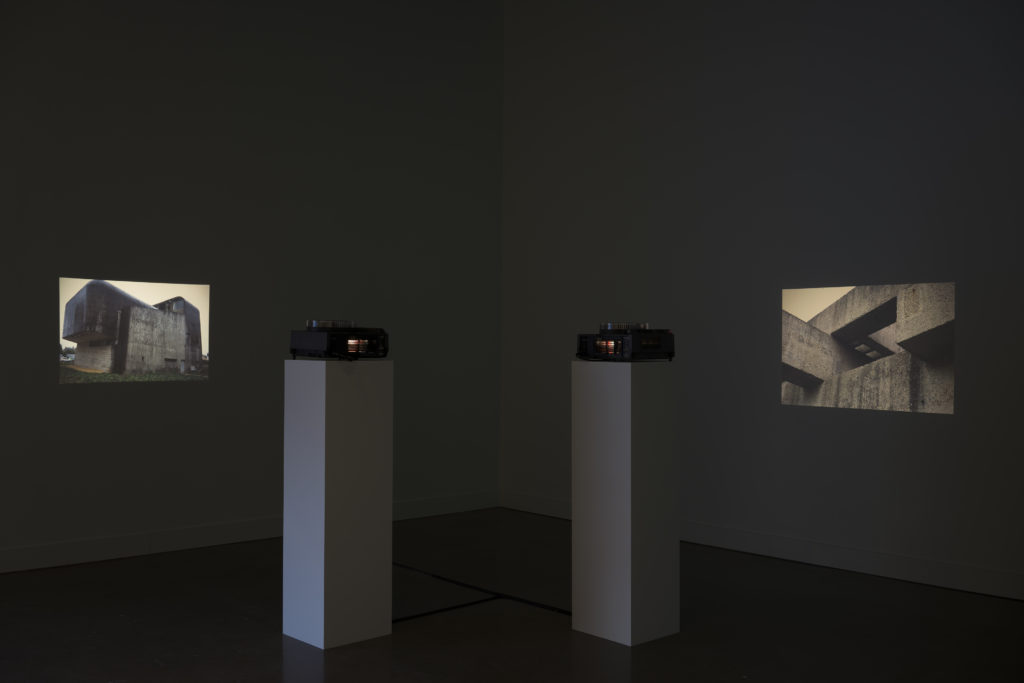
Exhibition installation view of Charlotte Moth: Seeing while Moving at MIT
List Visual Arts Center, Cambridge, MA (February 17–April 16, 2017)
Photo: Peter Harris Studio
The constant hum and shutter snap of the projector adds a counterpoint to the List Center’s open gallery space. The sound acts as another fragmentation, this time aural instead of visual. A piece titled For Claude Parent and Victor Pasmore (2016) is a voyeuristic look into private and nostalgic interior spaces. It is a look into another's, presumably Moth’s, domestic world but shot so that the viewer can find something familiar in this intimate space. Two projectors sit at diagonal corners to each other, timed so that the images flicker from one wall to the next. Most of these slides are of interiors. Instead of a family gathering to look at vacation slides, we are presented images of the home and reality, not vacation and fantasy. It holds up better in conjunction to Noting Thoughts and adds to the overall theme of ambiguous and fractured spaces.
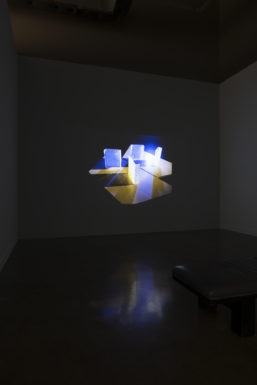
Exhibition installation view of Charlotte Moth: Seeing while Moving at MIT
List Visual Arts Center, Cambridge, MA (February 17–April 16, 2017)
Photo: Peter Harris Studio
One of the most engaging and enigmatic aspects of Seeing While Moving is the final piece, a video of mirrored objects, revolving and moving in space. Titled Study for a 16mm Film (2011), the piece is devoid of figures, like most of her photographed work, the movement comes from glass and mirrored objects placed on furniture. In these, the camera moves taking turns with the mirrored surfaces that revolve seemingly of their own accord. The luminous color and constant movement trick the eye into believing these little pieces have agency, like little actors set on a stage. They are intriguing because we can understand the solidity and reality of the objects, and yet, be wary of their form. Mirrored images hold no independent mass, only reflections of what the camera captures. So physical objects covered in reflective surfaces, reflecting each other become something otherworldly, caught in a loop of their own affirmation and self-erasure while the camera stands by to document this internal crisis.
Nothing is out of order in Seeing While Moving, Moth has created a series of photographs and an imagined life, and we are encouraged to weave in and out of fragmented memories with slow and methodical deliberation. Although Moth is the photographer, she is not the subject of her work.
Seeing While Moving’s success rests on its ability to ensure that viewer has enough room to breathe inside the airy photos, videos, and sculptures. Our personal perspective gradually takes over, and we can see yellowed vacation photos and postcards, tenderly laid out on display, all sense of that original sender wiped out in favor of something more ephemeral and reflective of the feeling we bestow upon them. Experiencing the show, I felt like a placeholder for a collective desire and unconscious memory. Like the mirrored objects revolving in space, we become a reflection of Moth’s memories, moving in and out of her own fragmented history. Every article is another layer to the interpretation of the original images and sculptures. Seeing While Moving is Charlotte Moth's way of understanding that thing just out of view, on the horizon, in the corner of our eye, familiar but just out of reach.

